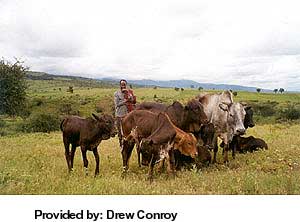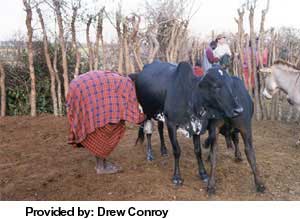Masai Cattle
 Also known by: Maasai
Also known by: Maasai
The life of the Masai tribe of Kenya and Tanzania revolve around cattle. Virtually all social roles and status derive from the relationship of individuals to their cattle. Cow's milk, together with blood, is the staple food of the Masai who eat no fruit or grain. Once a month, blood is taken from living animals by shooting a small arrow into the neck. This blood is then mixed with milk in a gourd which has been washed with urine to prevent spoilage.
Masai cattle vary considerably due to the centuries old practice of stealing cattle from neighboring tribes. This is sanctioned by the Masai legend with relates that Ngai (God) sent them cattle at the beginning of time and gave them the sole right to keep them. Compared with cattle belonging to the surrounding tribes, Masai cattle are the largest and in the best condition. This is due largely to the generous amount of milk the young calves get. As a rule, the Masai have so many cattle that only a portion of the milk is needed for human consumption and there is plenty left for the calves.
 Females stand 125 cm tall and weigh about 360 kg while bulls are 140 cm at the withers
and weigh 400 kg. The breed has a characteristically small narrow head. The dewlap
is quite large, the chest is relatively deep and the whole body is well muscled. Coloration
varies although the Masai favor brindled animals.
Females stand 125 cm tall and weigh about 360 kg while bulls are 140 cm at the withers
and weigh 400 kg. The breed has a characteristically small narrow head. The dewlap
is quite large, the chest is relatively deep and the whole body is well muscled. Coloration
varies although the Masai favor brindled animals.
References
Genus Bos: Cattle Breeds of the World, 1985, MSO-AGVET (Merck & Co., Inc.), Rahway, N.J.
Mason, I.L. 1996. A World Dictionary of Livestock Breeds, Types and Varieties. Fourth Edition. C.A.B International. 273 pp.
